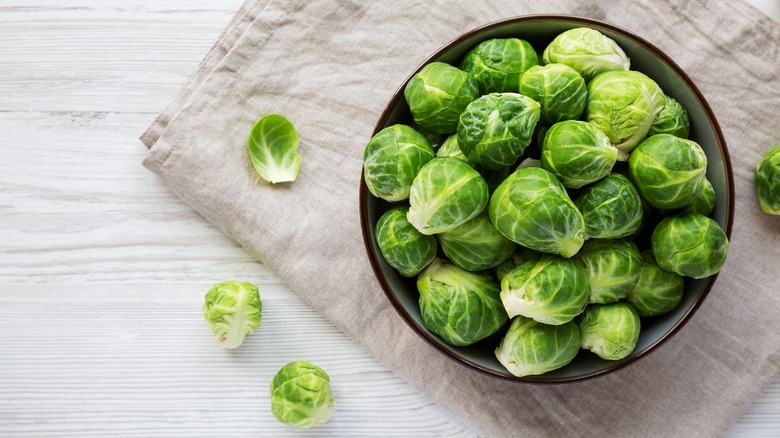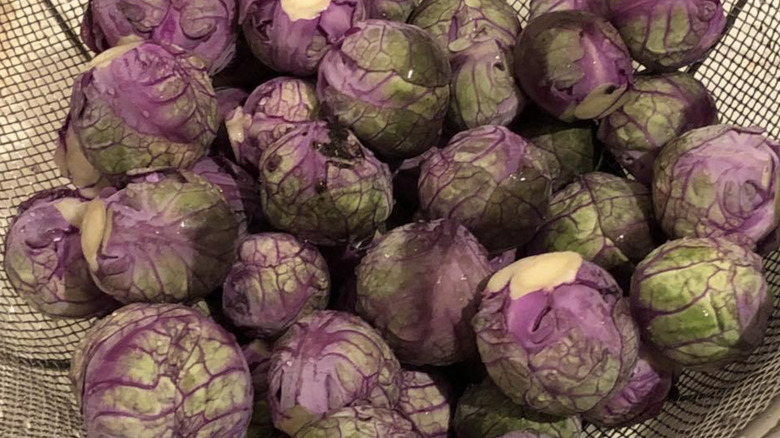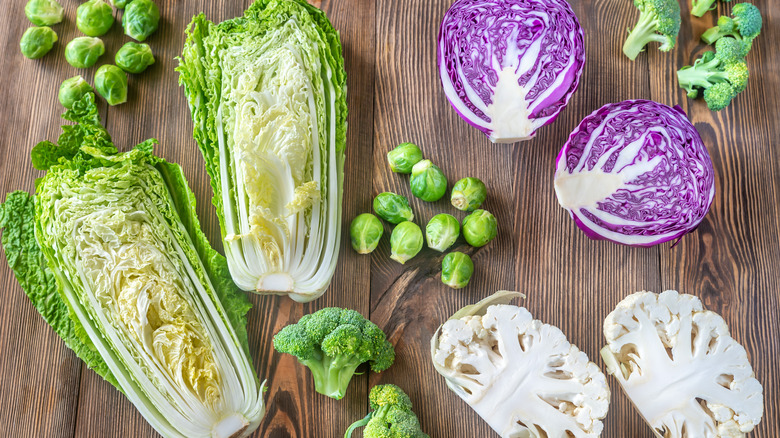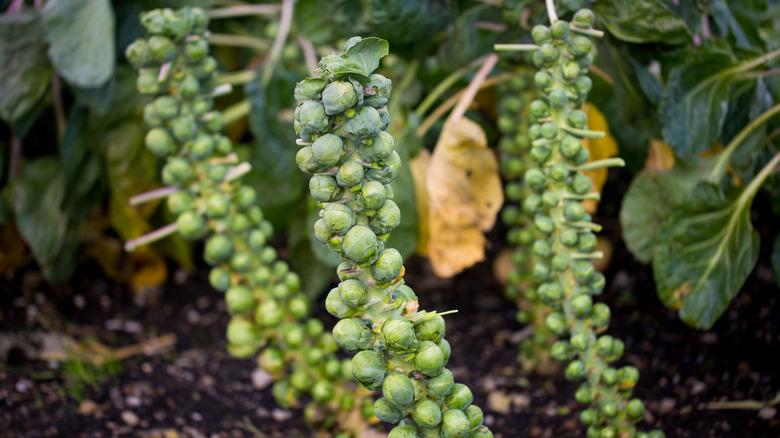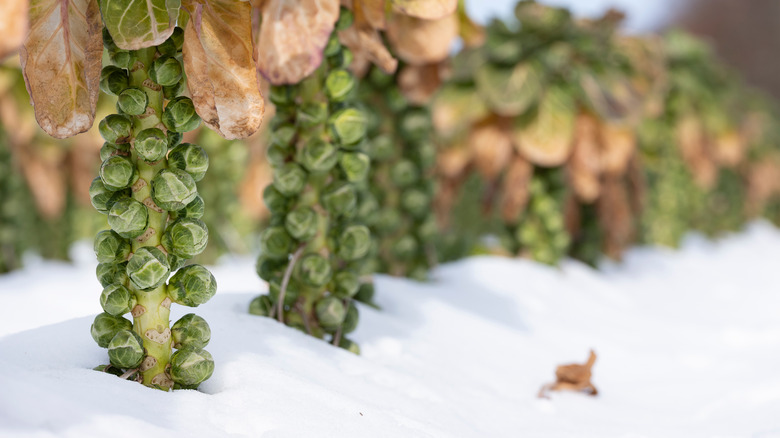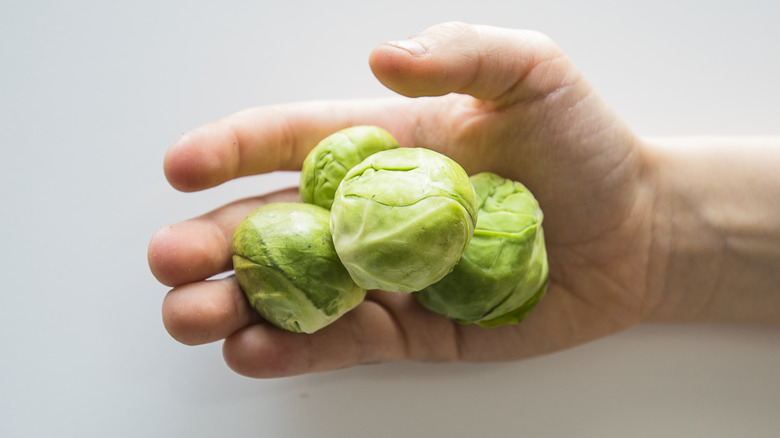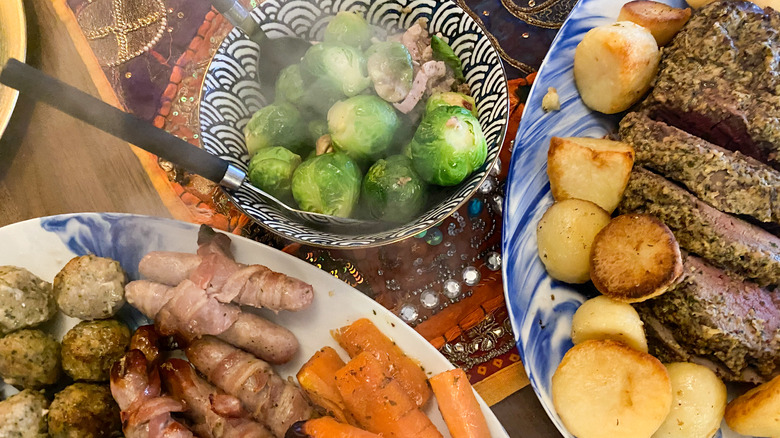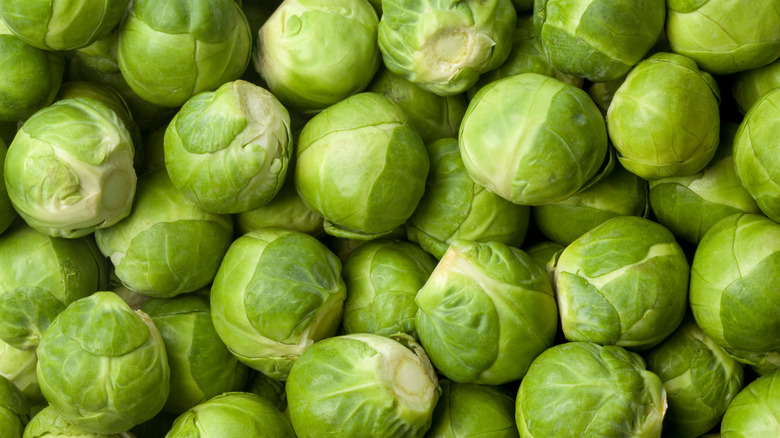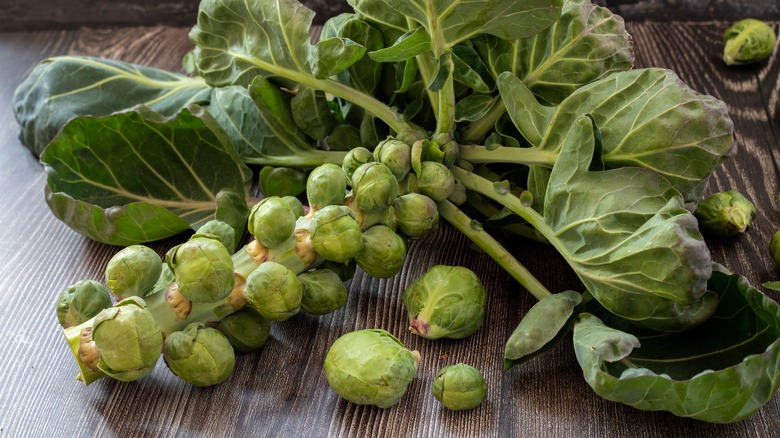What You Didn't Know About Brussels Sprouts
Slightly nutty and earthy in flavor, Brussels sprouts are one of those vegetables that people either love or hate. Perhaps this is the reason the mini cabbages don't commonly appear on restaurant menus in the U.S. However, despite their somewhat divisive reputation, Brussels sprouts are highly nutritious and low in calories, which makes them a great addition to any meal.
Taking their name from the capital of Belgium, Brussels sprouts made their way to the U.S. in the 18th century when they were brought to the country by French settlers. Today, the U.S. grows around 70 million pounds of Brussels sprouts per year. Each January, there's even an Eat Brussels Sprouts Day to remind everyone that the little green balls can be delicious. In fact, those who hate the cruciferous vegetables may be surprised at how versatile they can be in the kitchen. From pan-fried Brussels sprouts to Brussels sprouts with chestnuts and bacon, the mini cabbages can be easily turned into a variety of mouthwatering dishes.
Whether you're a fan of Brussels sprouts or still on the fence about their appeal, it pays to stay informed. Keen to find out more about this small cruciferous vegetable? Read on for more!
Brussels sprouts didn't originate in Brussels
While there's a definite connection between Brussels sprouts and the Belgian capital, the original version of Brussels sprouts didn't originate in the European city. Instead, it's likely that a version of the mini vegetable was already cultivated in ancient Rome before making its way to northern Europe around the 5th century. This begs the question: Why are Brussels sprouts called Brussels sprouts and not Roman sprouts?
While a type of Brussels sprouts may have been around for thousands of years, the vegetable we recognize today is named after the Brussels area, where it was cultivated in the 13th century. In fact, the little cabbage-like vegetable was already mentioned in 1213 regulatory guidelines for markets in the region of Brussels. Nevertheless, Brussels sprouts didn't become popular until the 16th century, when they were grown in the area that today encompasses the European countries of Holland, Belgium, Luxembourg, and areas of Germany.
There're different types of Brussels sprouts
We normally associate Brussels sprouts with a small, green, cabbage-like vegetable with a head of tightly packed leaves. While this indeed is the common Brussels sprouts variety out there, it's by no means the only one. In fact, over 110 different types of Brussels sprouts exist. While many varieties do resemble each other, some types of the mini vegetable do exhibit unique characteristics in terms of color and flavor.
One of the greatest differences between the types of Brussels sprouts is whether they grow on short plants up to 2 feet or taller plants between 2 and 4 feet. As you may have already guessed, the Brussels sprouts on the taller plants are larger than the ones that grow on their shorter counterparts. More specifically, the Brussels sprouts that grow on the smaller plants are the size of marbles, while their larger counterparts range between the size of ping pong and golf balls.
Perhaps the most unusual types of Brussels sprouts are Rubine and Falstaff. Purple in color, the appealing veggies are a cross between a Brussels sprout and a red cabbage. However, you are unlikely to find them at your local grocery store since they give smaller yields than green sprout types, which makes them unappealing for commercial purposes.
Brussels sprouts are a part of the cabbage family
Brussels sprouts don't look like mini cabbages by chance. Both are cruciferous vegetables — a group of garden produce that also includes broccoli, cauliflower, kale, and bok choy. Some more unexpected veggies that also belong to the same family are daikon radish, horseradish, turnip, wasabi, watercress, and even arugula lettuce. Also sometimes referred to as the Brassica oleracea family, cruciferous veggies are named after their flowers, which have four petals shaped a little like a crucifix or a cross.
Although cruciferous vegetables vary in shapes, colors, and flavors, they all have one important thing in common — they are all very good for you. Brassica oleracea plants contain glucosinolate, a phytochemical that has been studied for its anti-cancer effects. And while nothing concrete has been proven in that department, cruciferous vegetables are packed with other beneficial nutrients, including vitamins A and C, folic acid, iron, copper, calcium, zinc, and selenium.
Brussels sprouts grow on stalks
Have you ever thought about how Brussels sprouts actually grow? If you pictured them growing like little cabbages, scattered loosely across the soil, you'd be mistaken. They also don't grow in bunches like grapes on a vine. As strange as this may sound, Brussels sprouts grow on thick stalks, with countless sprouts clinging to a single vertical stem.
Internet users have expressed surprise at the growth process of Brussels sprouts, with one Reddit member saying: "The first time I saw what a stem of Brussels sprouts looked like, I thought it looked like a spinal column." Another Reddit user agrees that Brussels sprouts make for a "goofy plant," adding that the "huge, thick trunk gets very dense, the leaves are massive and very thick/waxy and cabbage-like."
Not many people realize that the stems of Brussels sprouts are edible and can be utilized in cooking. Firstly, you can brush the Brussels sprouts with a little olive oil and roast them right on the stalk in the oven. The stems of Brussels sprouts also make a nutritious addition to broths, soups, and stir-fries. This said, since the Brussels sprouts stalk is relatively fibrous in texture, it's important to peel off any tough outer layers before popping it in the pot.
The flavor of Brussels sprouts improves with cold weather
If you're one of those people who find Brussels sprouts overly bitter in flavor, there may be a solution. Many cruciferous vegetables are surprisingly winter hardy — and they may even taste better after a frost. While Brussels sprouts may not be the easiest vegetable to cultivate, they can withstand temperatures as low as 20 degrees Fahrenheit.
So why would Brussels sprouts taste sweeter after a little time in cold weather? When the temperature drops, Brussels sprouts break down starch into sugar. This makes the plants less likely to freeze in cold weather and turns them from a potentially bitter vegetable to a sweeter one. This means that the same type of Brussels sprouts cultivated in springs could taste completely different when grown in fall. Other vegetables that also taste sweeter after a frost due to the same process include root veggies such as carrots and parsnips.
Brussels sprouts are exceptionally nutritious
It's a well-known fact that veggies are loaded with vitamins, minerals, and antioxidants. As such, they're a crucial part of a balanced and healthy diet. Brussels sprouts are no exception. Firstly, Brussels sprouts are full of antioxidants, such as flavonoids, chlorophyll, and polyphenols, which help to prevent cell damage. They are also a great source of vitamin C, which supports the immune system, and vitamin K, which helps with blood clotting and contributes to healthy bones. Additionally, Brussels sprouts are rich in fiber, which assists in regulating blood sugar and improves gut health. Lastly, the mini cabbages also contain small quantities of vitamin B6, iron, magnesium, potassium, iron, and phosphorus.
Since Brussels sprouts lose their nutritional value over time, it's important to select vegetables at their peak of freshness. This usually means firm, green leaves. To get the most out of your Brussels sprouts, avoid vegetables with wilted leaves or any yellow or brown leaf discolorations. Alternatively, opt for frozen Brussels sprouts since they typically have the same nutritional benefits as their fresh counterparts.
Brussels sprouts smell unpleasant when overcooked
Most of us have probably had an unpleasant experience with Brussels sprouts smelling strange at one point in our lives. In fact, if overcooked, the miniature cabbages can stink up not just your kitchen but the entire house. So why is this happening, and, more importantly, what can you do about it? Cooking Brussels sprouts for too long releases isothiocyanates, sulfurous compounds that smell like — well — sulfur. Not just that, overcooking Brussels sprouts can also make them bitter and mushy. For best results, and a stink-free house, sauté or steam Brussels sprouts for no longer than 5-7 minutes. For oven roasting, initially begin with between 20-30 minutes before doing a taste test.
There are a few other things you can do to keep your cooked Brussels sprouts odor-free. Firstly, try to buy the smallest sprouts possible, as they tend to cook the quickest. In addition, you can cut an "X" into the base of each sprout to help it cook better without affecting its cabbage-like shape. If, despite these measures, your house still ends up smelling of sulfur, there are some simple things you can do to reduce the unpleasant odor. One of these is placing a bowl of coffee beans in your kitchen for a few hours. Alternatively, you can try covering the offensive smell by boiling some cloves or cinnamon sticks.
Brussels sprouts are a traditional part of Christmas dinner in the U.K.
Christmas dinner in the U.K. is about much more than just roasted turkey and potatoes, Yorkshire pudding, or pigs in blankets. A lesser-known Christmas specialty in the U.K. is Brussels sprouts. In fact, in 2022, The Standard reported that a Nationwide and Farmhouse Inns survey found that the green balls were a favorite Christmas vegetable for Brits, just ahead of broccoli, carrots, parsnips, and peas. According to the RHS, to satisfy their craving for the cruciferous vegetable, the U.K. has a dedicated area the size of 3,240 football pitches for their cultivation. And when it comes to the Christmas table in the U.K., Brussels sprouts are most commonly served either fried with bacon or steamed.
Brussels sprouts gained popularity in the U.K. in the 19th century; however, it's unclear how they became such an important part of the Christmas feast in the country. Nevertheless, food historian Angela Clutton has a theory that it was a simple matter of timing, which she shared with i News in an interview. "Sprouts only became widely available in Britain towards the end of the 1800s — around the time that our modern ideas of Christmas feasting were being 'invented' was just when sprouts started to be around too," Clutton said.
Brussels sprouts are high in protein
Protein contains amino acids, which are responsible for building and repairing cells and tissues like bones and muscles. The food that contains the highest protein level is meat, with chicken, beef, and pork leading the way in protein content. Dairy and fish such as tuna, eggs, yogurt also provide their fair share of the nutrient. The great news is that some veggies, such as Brussels sprouts, also contain significant amounts of protein.
For every 100 grams, Brussels sprouts contain 3.4 grams of protein and 43 calories, of which 31% come from protein. While this is a decent number as far as plant-based protein goes, it still doesn't match that of meat, fish, lentils, and tofu. As such, it's important to consume multiple sources of protein. If you're curious about other vegetables that are relatively high in protein, there are several greens that also offer notable amounts of the nutrient. Each 100 grams of spinach contains 2.9 grams of protein, asparagus 2.2 grams, broccoli 2.8 grams, and cauliflower 1.9 grams.
There's a genetic reason some of us dislike Brussels sprouts
Not everybody likes Brussels sprouts. In fact, some people are vehemently opposed to eating the little green balls. Up to recently, we were unaware of the reason that's likely to be contributing to this aversion. It took a Dutch scientist to bring us up to speed. In the 1990s, Hans van Doorn discovered that cruciferous vegetables, including Brussels sprouts, taste bitter to certain people due to glucosinolates. Interestingly, the capacity — or misfortune — to taste the bitter flavor caused by glucosinolates isn't inherent in all individuals. According to studies, our perception of bitter flavors is dependent on our genetics, including the TAS2R38 taste sensitivity gene.
Our love or hate of Brussels sprouts likely goes beyond genetics. It goes without saying that the way Brussels sprouts are prepared can go a long way in influencing our perception of the leafy green veggies. If, as children, we have experienced overcooked, mushy, and smelly Brussels sprouts, we're unlikely to be fans of them as adults. If, on the other hand, we have tasted more innovative Brussels sprouts recipes, such as Brussels sprouts combined with chorizo and aioli, we might have a greater appreciation for the little vegetable.
Brussels sprouts have been the subject of several Guinness World Records
While this may come as a surprise to some, the humble Brussels sprout has been the focus of numerous Guinness World Records. In 1992, Bernard Lavery from the U.K. established a world record for growing the heaviest Brussels sprouts plant, which weighed an impressive 18.3 pounds. In 2008, Linus Urbanec from Sweden was awarded the Guinness World Record for eating the most Brussels sprouts in one minute. Urbanec ate 31 Brussels sprouts using a cocktail stick, skewering and swallowing each green veggie one at a time.
The most recent Brussels sprouts-related Guinness World Record was set by Dickerson Philip from Hawthorne, California. Philip managed to grow the tallest Brussels sprouts plant at 10 feet 11.8 inches. When asked about the endeavor, Philip said that he got the idea when one of his Brussels sprout plants started to tower over the others. It wasn't long before he realized that the mammoth plant could make him a part of historical lore.
